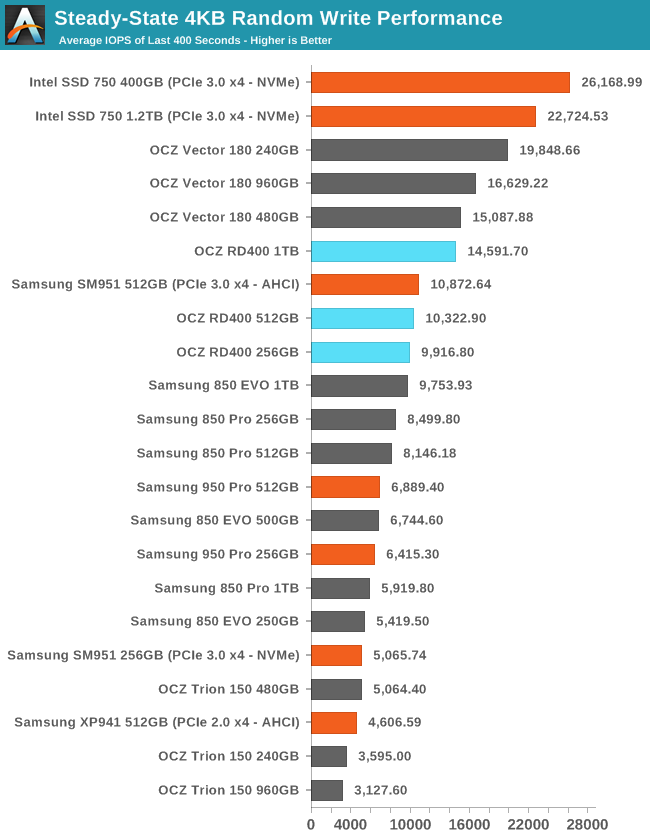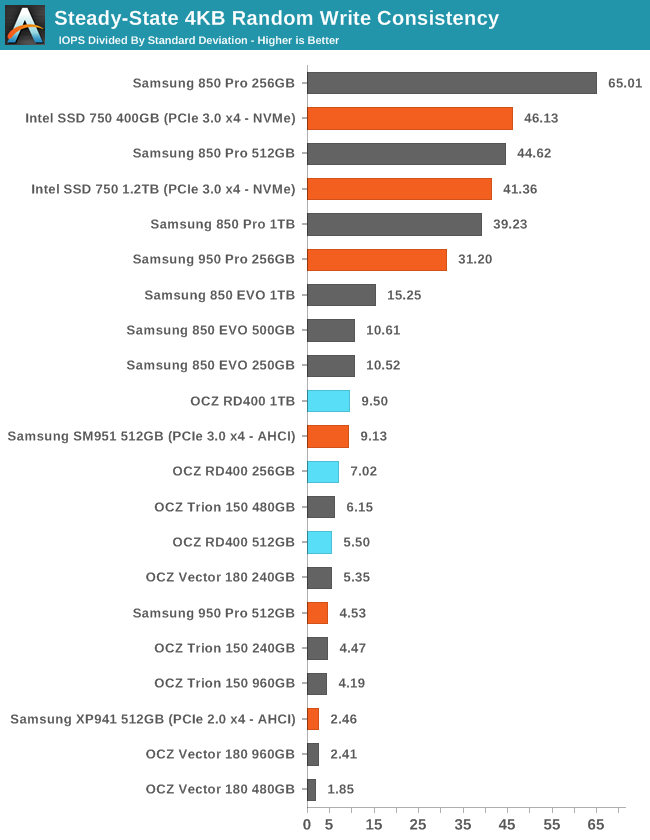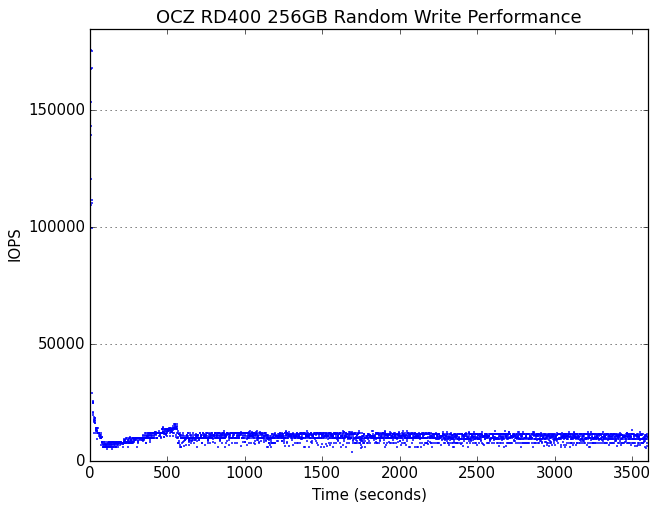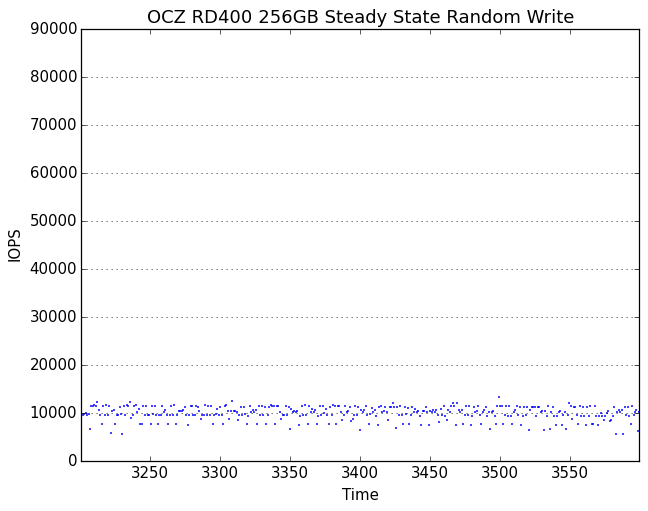The Toshiba OCZ RD400 (256GB, 512GB, 1TB) M.2 PCIe SSD Review
by Billy Tallis on May 25, 2016 8:02 AM ESTPerformance Consistency
Our performance consistency test explores the extent to which a drive can reliably sustain performance during a long-duration random write test. Specifications for consumer drives typically list peak performance numbers only attainable in ideal conditions. The performance in a worst-case scenario can be drastically different as over the course of a long test drives can run out of spare area, have to start performing garbage collection, and sometimes even reach power or thermal limits.
In addition to an overall decline in performance, a long test can show patterns in how performance varies on shorter timescales. Some drives will exhibit very little variance in performance from second to second, while others will show massive drops in performance during each garbage collection cycle but otherwise maintain good performance, and others show constantly wide variance. If a drive periodically slows to hard drive levels of performance, it may feel slow to use even if its overall average performance is very high.
To maximally stress the drive's controller and force it to perform garbage collection and wear leveling, this test conducts 4kB random writes with a queue depth of 32. The drive is filled before the start of the test, and the test duration is one hour. Any spare area will be exhausted early in the test and by the end of the hour even the largest drives with the most overprovisioning will have reached a steady state. We use the last 400 seconds of the test to score the drive both on steady-state average writes per second and on its performance divided by the standard deviation.

The RD400 sustains good random write performance, but the controllers and firmware in the OCZ Vector 180 and Intel 750 were designed with this kind of test in mind, and it shows. PCIe and NVMe don't help appreciably when the performance bottleneck is all the bookkeeping inside the controller, but NVMe controllers tend to have at least adequate processing power.

Most Samsung and Intel drives are much more consistent than the RD400, but the latter's score is fine for a client drive.
 |
|||||||||
| Default | |||||||||
| 25% Over-Provisioning | |||||||||
The 512GB RD400 shows oddly different behavior from the other two capacities when tested with overprovisioning, but the RD400 results are all good looking with no extremely low performance outliers.
 |
|||||||||
| Default | |||||||||
| 25% Over-Provisioning | |||||||||
The minimum random write performance of the RD400 is as good as the average performance of most SATA drives. There is some periodic variation apparent for the 512GB and 1TB models in the form of steep drops that last only a few seconds.










40 Comments
View All Comments
Samus - Wednesday, May 25, 2016 - link
I'm sure a multi billion dollar conglomerate decided to convert the 12v PCIe rail over drawing from the weak 3.3v rail for a reason. Probably something as simple as firmware flashing compatibility. Flashing firmware causes enormous voltage spikes that would easily surpass 10 watts @ 3.3vjjj - Wednesday, May 25, 2016 - link
It's a bit weird to state that the Samsung is the fastest when it loses in write and mixed workloads.Your own benchmark is read heavy but maybe not all readers care most about read perf.
LostWander - Wednesday, May 25, 2016 - link
Read seems to be the most common trait people look for, so if they had to pick one I would agree on that. Kinda odd to give it the title though with no single drive leading in more than a couple benchmarks, it's only "the fastest" in relatively specific categoriesBilly Tallis - Wednesday, May 25, 2016 - link
The Samsung 950 Pro is clearly faster on the ATSB Heavy test which writes more than twice as much data as it reads. If you have a workload that is so much more write heavy that the RD400 comes out ahead, then it's quite atypical and you shouldn't expect our general-audience recommendations to apply.DanNeely - Wednesday, May 25, 2016 - link
If you're mostly writing data that never gets read back again, you're one of the use cases that really still does work well with much cheaper spinning rust.jjj - Wednesday, May 25, 2016 - link
And yet you have more read IOs. Would be interesting to see what you get if you remove at least games and web from that test.Another factor to consider is when you need the perf and when you don't.
I wouldn't buy a drive like this for web browsing or watching video.Would prefer the drive not to choke when you really put pressure on it.
Write is also trailing far behind in data rates and that's not great, do you really like such an unbalanced drive? When your verdict is all about read perf ,maybe a more granular verdict is better. If you would do the math in % for read, write and mixed who wins?
Maybe i am being lazy but can't seem to find any info on multitasking and the system used. Do any of the tests run multiple things at once and are you using an 8 cores? With Zen arriving soon 8 cores/16 threads should become much more popular as the die should be pretty small -y guess somewhere between 99 and 131mm2.
The Samsung feels like a mobile SoC that throttles.Does great when you don't really need the perf but lets you down when you need it. That being said, looking forward to Samsung's new drives (961), on paper those are much better.
Impulses - Wednesday, May 25, 2016 - link
Have you actually used an SM951 or 950 Pro? I've been running one for a while and I don't find the SoC comparison very accurate, mine has a decent amount of airflow going over it (tho it's still near a hot GPU)...AT's own tests proved throttling, when it does happen, wasn't a big deal.
I guess if you're constantly dumping GBs upon GBs of data on one from an equally fast source then yeah, it's gonna be throttle city, but that's not the usage case I see for them.
At least given the current capacity/costs...
jjj - Wednesday, May 25, 2016 - link
You misunderstood, the comparison wasn't about the cause but the effect. Here the weakness is write and mixed workloads but the effect is similar, it lets you down when you need it most.stux - Thursday, May 26, 2016 - link
I use one of the Sm951s in an AngelBird PCI adapter. Takes care of the throttling issue, it never goes above 41C.And it's fantastic :)
theduckofdeath - Wednesday, May 25, 2016 - link
For a consumer PC read performance is nearly infinitely more relevant than random write performance. That's probably why. :)